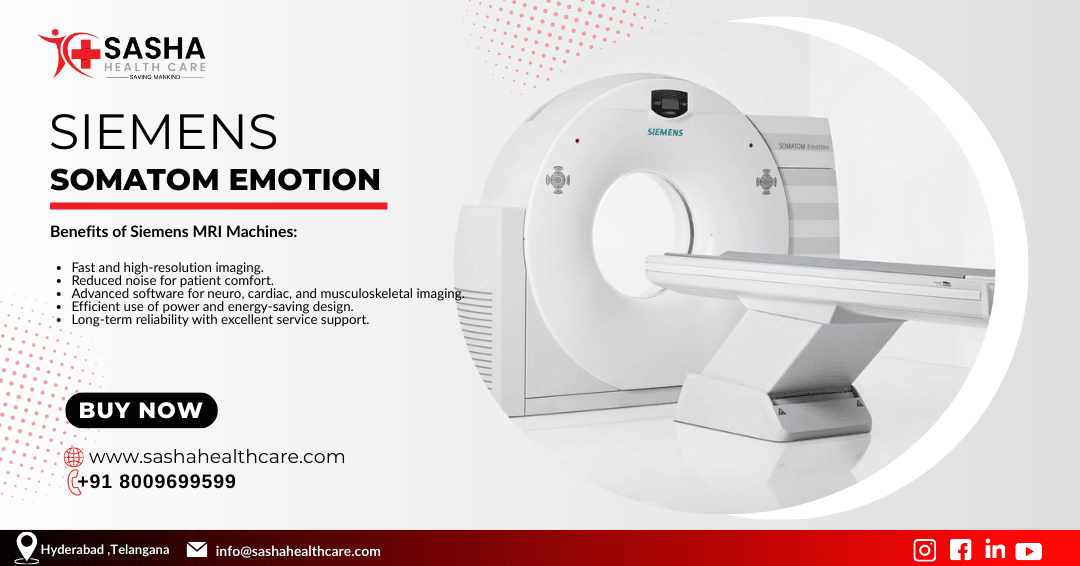CT Scan Machine Siemens – Specifications, Suppliers, and Uses
The CT Scan Machine Siemens stands at the forefront of medical imaging technology, delivering precision, speed, and clarity in diagnostics. Hospitals, diagnostic centers, and healthcare providers trust Siemens for its innovative approach to computed tomography, ensuring superior patient care and operational efficiency. This article explores its specifications, the role of trusted suppliers, and common uses in modern healthcare.
Why Choose CT Scan Machine Siemens?
Siemens has built a global reputation for designing CT systems that combine advanced imaging capabilities with patient comfort. Their machines are engineered to provide faster scan times, reduced radiation doses, and high-resolution images, enabling physicians to make confident decisions quickly.
Key Benefits:
- High-quality imaging with advanced detector technology.
- Low-dose scanning to minimize patient exposure.
- User-friendly interface for technologists and radiologists.
- AI integration for faster post-processing and reporting.
CT Scan Machine Specifications
When evaluating a CT scanner, specifications play a vital role in determining its suitability for various clinical applications. Siemens offers models ranging from entry-level systems to high-end multi-slice scanners used for complex diagnostics.
Typical Specifications Include:
- Slices per rotation: 16 to 320 slices
- Gantry rotation time: 0.25 to 0.5 seconds
- Detector type: Solid-state, high-efficiency detectors
- Patient table load capacity: 200–300 kg
- Spatial resolution: Sub-millimeter precision
- Radiation dose reduction technology: Iterative reconstruction algorithms
- Software features: 3D reconstruction, cardiac imaging, perfusion studies
These specifications ensure flexibility in scanning everything from routine head CTs to advanced cardiac and oncology imaging.
CT Scan Machine Suppliers
Acquiring a Siemens CT scanner requires working with reliable CT scan machine suppliers who can ensure authenticity, installation, and after-sales service. Trusted suppliers offer comprehensive packages, including warranty, operator training, and preventive maintenance.
Qualities of a Reliable Supplier:
- Direct partnerships with Siemens or authorized distributors.
- Competitive pricing with transparent quotations.
- Technical support and spare parts availability.
- Proven track record with hospital and diagnostic center installations.
- Financing or leasing options for budget flexibility.
For healthcare providers in India, choosing the right supplier ensures not just the delivery of the machine, but long-term operational efficiency and uninterrupted service.
CT Scan Machine Uses
The versatility of a CT Scan Machine Siemens makes it a cornerstone of modern diagnostics. From detecting early signs of disease to guiding surgical planning, its applications span multiple medical specialties.
Common Uses Include:
- Neurology: Detecting brain hemorrhages, strokes, and tumors.
- Cardiology: Assessing coronary arteries, calcium scoring, and cardiac function.
- Oncology: Staging cancers, monitoring treatment response.
- Orthopedics: Evaluating bone fractures and joint abnormalities.
- Emergency Care: Rapid trauma assessment for internal injuries.
- Pulmonology: Diagnosing lung diseases such as COVID-19 pneumonia or pulmonary embolism.
Advanced Features in Siemens CT Systems
Modern Siemens CT machines are not just about imaging—they integrate advanced technologies that improve workflow, safety, and diagnostic accuracy.
Notable Features:
- Dual-source scanning for faster cardiac imaging without motion artifacts.
- Automated patient positioning for accurate scan alignment.
- Dose optimization software to ensure minimal exposure.
- Real-time image reconstruction for immediate review.
- Pediatric-friendly protocols for safer scans in children.
Choosing the Right CT Scan Machine Siemens Model
Selecting a model depends on your patient volume, clinical needs, and budget. Smaller clinics may opt for 16- or 32-slice systems for routine imaging, while tertiary hospitals benefit from 128-slice or higher systems for advanced diagnostics.
Decision Checklist:
- Patient demographics and case mix.
- Budget constraints and financing availability.
- Space requirements in the imaging department.
- Software upgrade potential for future needs.
- Service and maintenance agreements.
Maintenance & After-Sales Support
Even the most advanced CT scanner requires regular servicing to ensure optimal performance. Siemens-authorized service providers and trained engineers can extend the life of your investment.
Best Practices for Maintenance:
- Schedule preventive maintenance every 6–12 months.
- Use only Siemens-approved spare parts.
- Keep software updated for better performance.
- Train operators on correct machine handling.
FAQ
A1: Siemens machines offer advanced imaging quality, faster scan times, and low-dose technology, ensuring patient safety and diagnostic accuracy.
A2: Specifications include 16–320 slices, rapid gantry rotation, high-efficiency detectors, and advanced dose reduction technology.
A3: Authorized Siemens distributors and reputed medical equipment suppliers with installation and service support are the best sources.
A4: Common uses include neurology, cardiology, oncology, orthopedics, pulmonology, and emergency trauma assessments.
A5: Preventive maintenance every 6–12 months is recommended to ensure peak performance and longevity.
Conclusion
The CT Scan Machine Siemens is a benchmark in the medical imaging industry, offering unmatched quality, advanced features, and reliable performance. By understanding its specifications, sourcing from trusted suppliers, and utilizing it for a wide range of clinical applications, healthcare providers can ensure accurate diagnosis and better patient outcomes.


